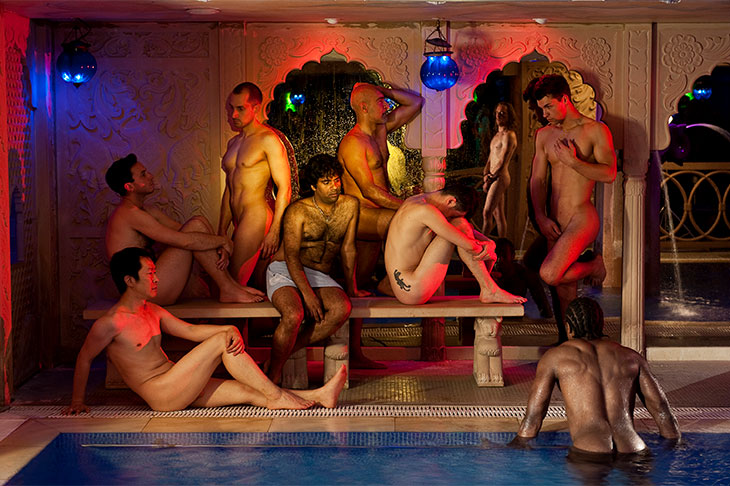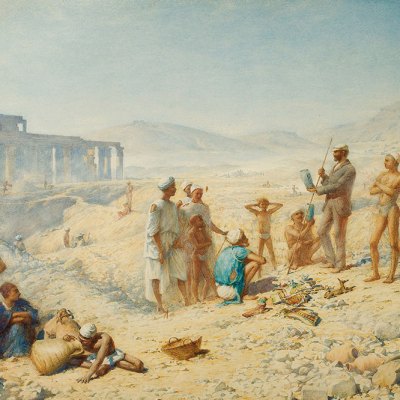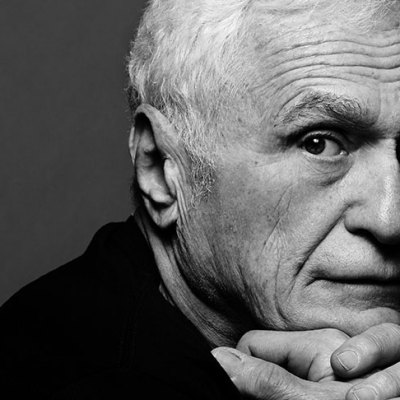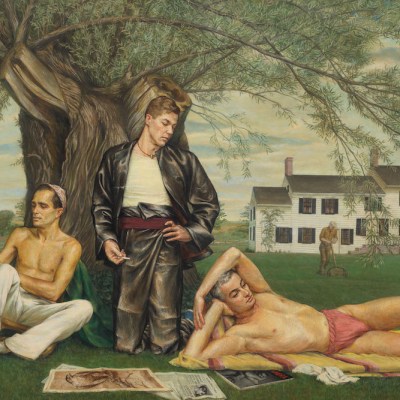This first major retrospective in Britain of Sunil Gupta’s work gives an overview of his career, from his teenage years in Montreal, where he moved with his parents from New Delhi in 1969, to long-term projects begun in the last decade and still in progress. Although the kind of photographs he takes have changed over the years, certain themes – family, sexuality, race, politics and exile – have remained constant. The earliest images are of friends and family in Canada, but in his twenties Gupta moved to New York, where in 1976 he took a series of black-and-white photographs of people on Christopher Street, the city’s first ‘gay district’. He then moved to England, where he completed an MA in photography at the Royal College of Art, and again photographed people in the streets, this time in colour and more or less at random.
These are all essentially documentary photographs, but in the early 1980s Gupta returned to India to produce a series of carefully composed large-scale images of gay men, often posed against ancient monuments and, since homosexuality was then illegal, with their faces cut off or obscured. The exception is a photograph of Gupta himself embracing the historian and gay activist Saleem Kidwai, both looking at the camera, with the Qutb Minar in the background. This monument is, perhaps significantly, a victory tower, but it would be another 35 years before homosexuality was decriminalised in India.
Legal or not, homosexual activity had of course always been pursued there, and in 1987 Gupta embarked on a series of photographs of the places gay men met in Delhi. These are accompanied by quotations from the men themselves, some of them very much at odds with India’s official view of homosexuality: ‘Police operate here harassing people and intimidating them with beatings and extortion. Sometimes they just want a blow-job’ (Nehru Park), or ‘I love this part of town. It’s got such character and you can have sex just walking in the crowd’ (outside Jama Masjid, Delhi’s famous mosque).
Jama Masjid (1987), from the series Exiles, Sunil Gupta. Courtesy the artist and Hales Gallery, Stephen Bulger Gallery and Vadehra Art Gallery; © Sunil Gupta, All Rights Reserved, DACS 2020

These photographs were included in the recent ‘Masculinities’ exhibition at the Barbican, and Gupta’s work often challenges ideas of maleness. Running parallel in India with the emphasis on family, marriage and traditional male and female roles is a long and less straightforward story that includes a distinct homoerotic strain in Sufi poetry, a good deal of sexual fluidity in Hindu mythology, and the many communities of hijra or ‘eunuchs’, who are now legally recognised as a third gender. Nothing, however, could be more traditionally masculine than the Indian armed forces, in which Gupta’s father served. A striking image in the Trespass series (1992–95) digitally merges a group photo of recruits outside a Services Selection Board office with a shot of a naked man standing in a kitchen, a space that in traditional terms is invariably female but in which Gupta regularly cooked meals for his male lovers. The image is presented in a triptych that includes a panel with the same naked man placed alongside a popular print of the revolutionary Chandra Shekhar Azad (1906–31), who is moustachioed, stripped to the waist and hung about with a cartridge belt and revolver, but looks – to Western eyes, at least – equally feminised. In Gupta’s works from this series the images are generally allowed to speak for themselves, without captions, but they remain just as subversive.
Gupta’s abiding preoccupation with people as outsiders in society embraces race as well as sexuality. Reflections of The Black Experience (1986) was a Greater London Council commission about the everyday lives of immigrants. In ‘Pretended’ Family Relationships (1988) he juxtaposes colour photographs of interracial gay and lesbian couples with severely cropped black-and-white images of a demonstration against the Conservative government’s notorious Clause 28, which banned schools from presenting homosexual relationships as equivalent to heterosexual ones. Among the videos in the exhibition is one Gupta made promoting Aids awareness that features two non-white men gleefully talking about, and demonstrating, the joys of safe sex. This was a bold commission from the Health Education Authority in 1991, which nevertheless discarded Gupta’s original title, Cock Crazy or Scared Stiff, for the more sober Building Your Confidence.
Untitled #9 (2010), from the series Sun City, Sunil Gupta. Courtesy the artist and Hales Gallery, Stephen Bulger Gallery and Vadehra Art Gallery; © Sunil Gupta, All Rights Reserved, DACS 2020

In later work Gupta uses multiple images to create narratives. While Country: Portrait of an Indian Village (1982–ongoing), documenting his family’s roots in a small village in Uttar Pradesh, is based in everyday reality, Sun City (2010) uses actors to create scenes from an imagined gay life: photographs of a couple greeting each other at an airport or shopping for clothes sit beside scenes from bars and bathhouses influenced by the work of Baron Wilhelm von Gloeden. The New Pre-Raphaelites (2008) is equally ‘staged’ and wittily responds to Section 377 of the Indian penal code, which outlawed homosexuality and was introduced by the British in 1861, by recreating paintings of that period using Indian (and often queer) models.
This retrospective is necessarily selective rather than comprehensive, and only three of the Pre-Raphaelites images are represented, presumably for reasons of space since they are as large as they are gorgeous. More of Gupta’s work, however, along with pictorial evidence of his longstanding involvement with campaigns surrounding race and sexuality, is featured in the book that accompanies the exhibition, which is not a catalogue but an evocative autobiographical scrapbook.
Untitled #7 (2008), from the series The New Pre-Raphaelites, Sunil Gupta. Courtesy the artist and Hales Gallery, Stephen Bulger Gallery and Vadehra Art Gallery; © Sunil Gupta, All Rights Reserved, DACS 2020

‘From Here to Eternity: Sunil Gupta – A Retrospective’ is at the Photographers’ Gallery, London, until 24 January 2021.



